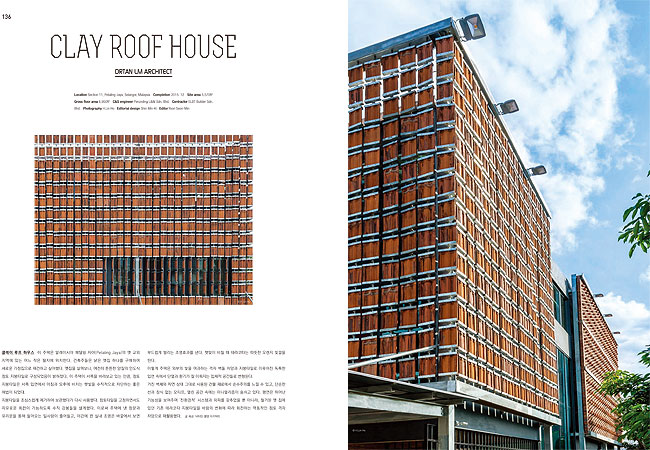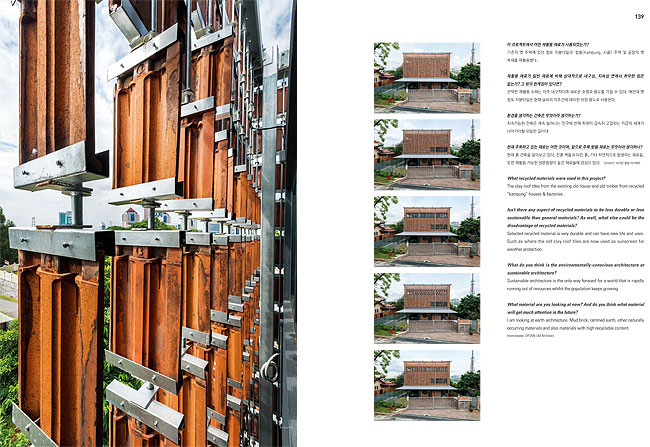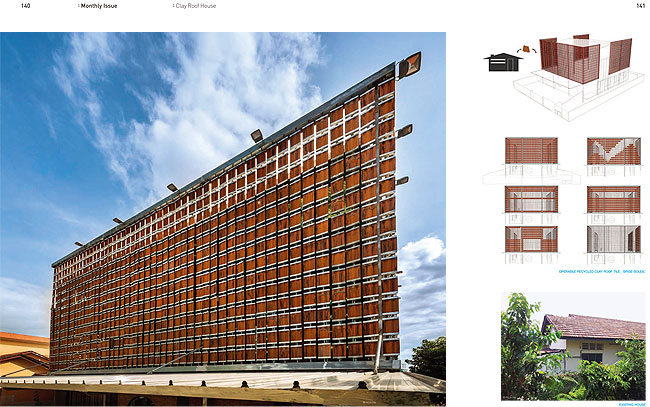Clay Roof House
DRTAN LM Architect



클레이 루프 하우스 이 주택은 말레이시아 페탈링 자야(Petaling Jaya)의 옛 교외 지역에 있는 어느 작은 필지에 위치한다. 건축주들은 낡은 옛집 하나를 구매하여 새로운 가정집으로 재건하고 싶어했다. 옛집을 살펴보니, 여전히 튼튼한 양질의 인도식 점토 지붕타일로 구성되었음이 밝혀졌다. 이 주택이 서쪽을 바라보고 있는 만큼, 점토 지붕타일은 서쪽 입면에서 아침과 오후에 비치는 햇빛을 수직적으로 차단하는 좋은 해법이 되었다.
지붕타일을 조심스럽게 제거하여 보관했다가 다시 사용했다. 점토타일을 고정하면서도 자유로운 회전이 가능하도록 수직 강봉들을 설계했다. 이로써 주택에 낸 창문과 유리문을 통해 들어오는 일사량이 줄어들고, 야간에 켠 실내 조명은 바깥에서 보면 부드럽게 떨리는 조명효과를 낸다. 햇빛이 비칠 때 테라코타는 따뜻한 오렌지 빛깔을 띤다.
이렇게 주택은 외부의 빛을 여과하는 격자 벽돌 차양과 지붕타일로 이루어진 독특한 입면 속에서 단열과 환기가 잘 이뤄지는 입체적 공간들로 변형된다. 거친 벽체와 자연 상태 그대로 사용된 건물 재료에서 순수주의를 느낄 수 있고, 단순한 선과 장식 없는 모티프, 열린 공간 속에는 미니멀리즘이 숨쉬고 있다. 평면은 뛰어난 기능성을 보여주며‘ 친환경적’ 시스템과 외피를 갖추었을 뿐 아니라, 철거된 옛 집에 있던 기존 테라코타 지붕타일을 바람의 변화에 따라 회전하는 역동적인 점토 격자 차양으로 재활용했다.
글 제공: 닥터탄 엘엠 아키텍트
이 프로젝트에서 어떤 재활용 재료가 사용되었는가?
기존의 옛 주택에 있던 점토 지붕타일과‘ 캄퐁(Kampung, 시골)’ 주택 및 공장의 옛 목재를 재활용했다.
재활용 재료가 일반 재료에 비해 상대적으로 내구성, 지속성 면에서 취약한 점은 없는가? 그 밖의 한계점이 있다면?
선택한 재활용 소재는 아주 내구적이며 새로운 수명과 용도를 가질 수 있다. 예컨대 옛 점토 지붕타일은 현재 날씨의 악조건에 대비한 차양 용도로 사용된다.
환경을 생각하는 건축은 무엇이라 생각하는가?
지속가능한 건축은 계속 늘어나는 인구에 반해 자원이 급속히 고갈되는 지금의 세계가 나아가야할 유일한 길이다.
현재 주목하고 있는 재료는 어떤 것이며, 앞으로 주목 받을 재료는 무엇이라 생각하나?
현재 흙 건축을 알아보고 있다. 진흙 벽돌과 다진 흙, 기타 자연적으로 발생하는 재료들, 또한 재활용 가능한 성분함량이 높은 재료들에 관심이 있다.
인터뷰이: 닥터탄 엘엠 아키텍트
The House is located on a small lot in the older suburbs of Petaling Jaya. The owners had purchased an old dilapidated house and wanted to rebuild a new family home. Upon inspection it was discovered that the old house had good quality Indian clay roof tiles that were still robust. And as the property faced west, the clay roof tiles offered a good solution to vertically screen the facade from the morning and afternoon sun. The roof tiles were carefully removed, stored and reused. Vertical steel rods were designed to hold the clay tiles whilst allowing free movement to swivel and turn. This reduces the solar gain through the house’s fenestration of windows and glass doors and lends a soft tremulous lighting effect when viewed with internal lights switched on at night from the outside. In the sun the terracotta glows a warm orange.
This transformed the house into an insulated and well-ventilated cube comprising volumes of spaces within a unique facade of roof tile and lattice brick work screens that shields the inside from the outside. There is a touch of purism in the raw walls and use of building materials in its natural form, a breath of minimalism in the simple lines, unornamented motifs and open spaces. With noticeable functionality in the floor plan, ‘green’ systems and outer skins as well as the reuse of the original terracotta roof tiles of the demolished old house as a lattice screen of animated clay that swivels with the undulating wind.
Text offer: DRTAN LM Architect
What recycled materials were used in this project?
The clay roof tiles from the existing old house and old timber from recycled “kampung” houses & factories.
Isn’t there any aspect of recycled materials to be less durable or less sustainable than general materials? As well, what else could be the disadvantage of recycled materials?
Selected recycled material is very durable and can have new life and uses. Such as where the old clay roof tiles are now used as sunscreen for weather protection.
What do you think is the environmentally-conscious architecture or sustainable architecture?
Sustainable architecture is the only way forward for a world that is rapidly running out of resources whilst the population keeps growing.
What material are you looking at now? And do you think what material will get much attention in the future?
I am looking at earth architecture. Mud brick, rammed earth, other naturally occurring materials and also materials with high recyclable content.
Interviewee: DRTAN LM Architect
건축문화 2016년 8월호 [Monthly Issue]페이지 © 에이엔씨출판(주)